The Baltimore and Potomac (B&P) Tunnel Project will replace the existing 147-year old, 2.25km-long rail tunnel located along the Northeast Corridor (NEC) in Baltimore, Maryland, US.
The ageing B&P tunnel faces problems such as water infiltration and a sinking floor. It is a deteriorating structure that operates at full capacity and its tight curvature causes train delays on a regular basis.
American rail transportation company Amtrak, which owns the existing tunnel, and its partners Federal Railroad Administration (FRA), the Maryland Department of Transportation (MDOT) and the City of Baltimore will modernise and transform a 6.43km-long section of the NEC as part of the tunnel replacement project.
Currently in the design phase, the project will involve a total estimated investment of approximately $4bn. Preliminary work is expected to begin in 2022, while the first bridge replacement is scheduled for 2023.
Background of B&P tunnel replacement project
Built in 1873, the B&P tunnel is the oldest tunnel of Amtrak and one of the oldest structures on the NEC. It comprises three shorter tunnels, namely John Street, Wilson Street, and Gilmor Street tunnels, separated by two, short, open-air sections known as the Pennsylvania Avenue Opening and the John Street Opening.
The B&P tunnel is used for Maryland Area Rail Commuter (MARC) passenger trains, Regional and Acela intercity rail passenger trains, and Norfolk Southern Railway (NS) freight trains.
The tunnel is located beneath West Baltimore in the vicinity of the neighbourhoods of Bolton Hill, Reservoir Hill, Sandtown-Winchester, Madison Park, and Upton and to the south of Pennsylvania Station.
The two-track tunnel connects the Pennsylvania Station in Baltimore to Washington and Virginia. It serves nine million MARC and Amtrak customers.
The B&P tunnel is nearing the end of its service life and does not comply with modern design standards. It lacks the capacity to meet current and future rail demands, affecting the rail operations along the NEC, which is one of the busiest lines in the country. The short, single-bored tunnel was rehabilitated in the 1980s, and ongoing repairs are necessary to keep the structures in good condition.
The existing tunnel is an important connection in Amtrak’s NEC which passes through eight states and Washington, DC.
B&P tunnel replacement project details
The new tunnel will be known as Frederick Douglass tunnel, named after late American social reformer and abolitionist Frederick Douglass.
The B&P Tunnel replacement programme will be executed in phases. The initial phase will include the construction of new roadway and railroad bridges, two new high-capacity tubes for electrified passenger trains, and a new West Baltimore MARC station that will meet the standards of the Americans with Disabilities Act (ADA). New rail systems and tracks will also be installed during the phase. Two additional tunnel tubes to accommodate freight trains are planned to be built at a later stage.
The new Frederick Douglass Tunnel will serve all MARC Penn Line commuter trains and Amtrak trains. The MARC commuter trains operating on the Penn Line will be electrified by MDOT through the new Frederick Douglass Tunnel. A ventilation plant will be built on North Avenue in West Baltimore to offset diesel rail emissions.
The project will also involve the development of solar power generation infrastructure at several locations to improve the sustainability of the NEC.
The new tunnel will be installed with advanced fire and life safety systems, including emergency exit pathways and ventilation equipment to ensure passenger safety during emergencies.
Frederick Douglass Tunnel project benefits
The B&P Tunnel replacement project along the NEC will eliminate the bottleneck on the section between Washington and New Jersey, leading to increased speed and rail capacity. It will also improve reliability for Amtrak and MARC trains by making them less prone to maintenance delays.
The trains running on the new tunnel will be able to travel at a speed of 160.93km/h instead of the existing speed of 48.28km/h, reducing the travel time between Baltimore and Washington, DC to 30 minutes. Upon completion, the tunnel will reduce rail delays by approximately seven hours a day on weekdays.
The new B&P tunnel project is anticipated to generate approximately 30,000 jobs, including 20,000 jobs during the construction phase. Furthermore, the project will involve an investment of more than $50m in community initiatives such as development grants to non-profit organisations, park and streetscape improvements, and infrastructure upgrades for cyclists and pedestrians.
Contractors involved
American project and construction management consultancy firm Paco Group provided value engineering (VE) services for the B&P Tunnel replacement project, as a part of the VE team comprising HNTB, McKissack & McKissack, and DACK Consulting Solutions.
HNTB provided services such as preliminary engineering support, design reviews, project controls, VE, and coordination of the environmental review process in accordance with the National Environmental Policy Act.
The company also coordinated community engagement and acted as a management consultant for the project.
US-based civil engineering company RK&K conducted environmental studies for the new tunnel project. It prepared the Draft Environmental Impact Statement (EIS), Final EIS and Record of Decision for the project.




